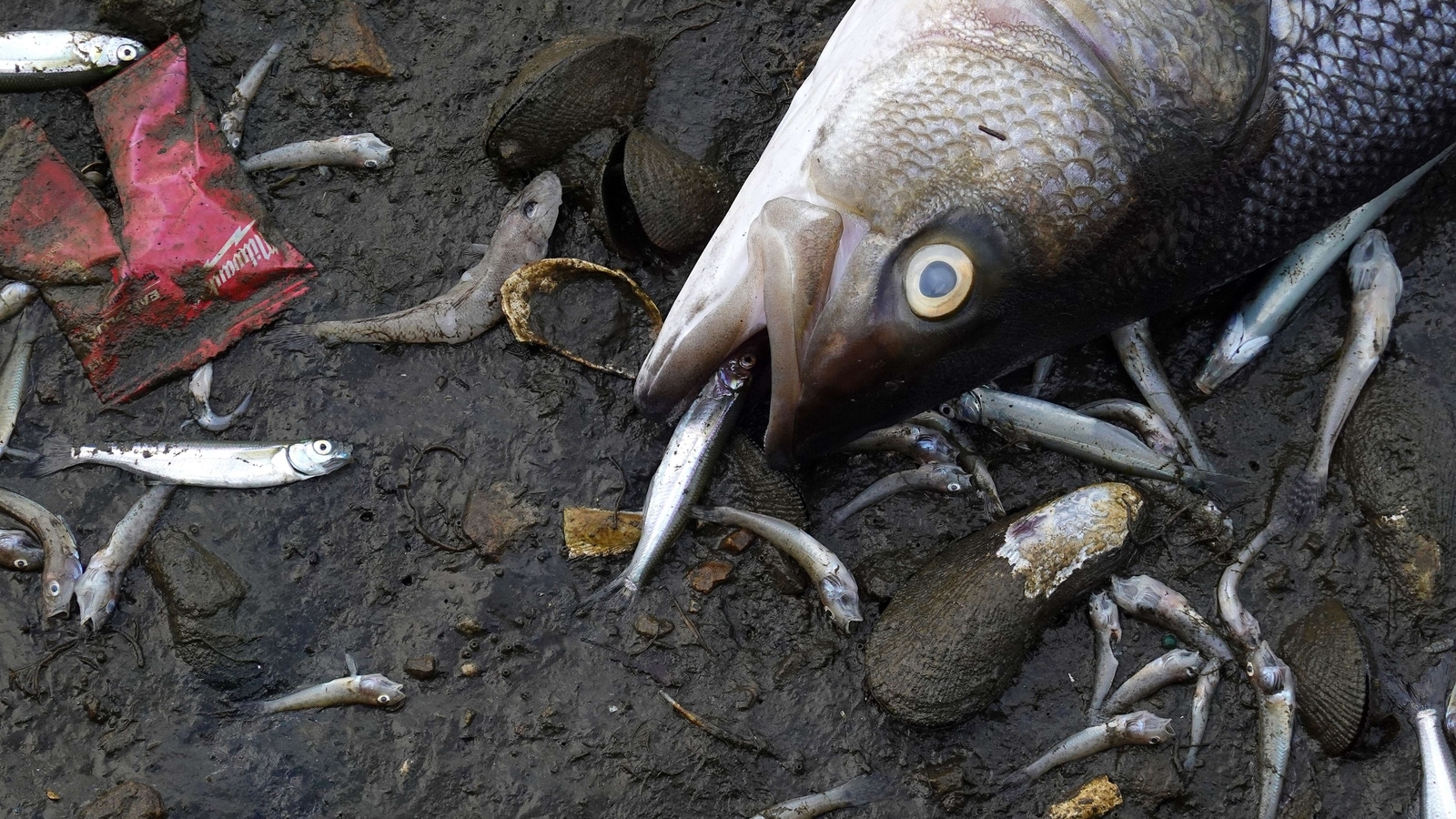California Coast Algae Bloom: Impacts On Marine Ecosystems

Table of Contents
The breathtaking beauty of the California coast is increasingly threatened by a growing menace: the proliferation of algae blooms. These seemingly innocuous blooms, often vibrant green or reddish-brown, are having devastating consequences for the delicate balance of the marine ecosystem. This article explores the far-reaching impacts of the California Coast Algae Bloom on the environment, economy, and human health. We will examine the multifaceted nature of this ecological challenge and discuss potential mitigation strategies.
<h2>Environmental Impacts of California Coast Algae Blooms</h2>
The environmental consequences of California coast algae blooms are profound and widespread, impacting the very fabric of the marine ecosystem.
<h3>Oxygen Depletion and Dead Zones</h3>
Excessive algae growth, often fueled by nutrient runoff from agricultural lands and urban areas, leads to a phenomenon known as eutrophication. As these algae die and decompose, bacteria consume vast quantities of dissolved oxygen in the water, creating hypoxic (low-oxygen) or even anoxic (oxygen-depleted) zones, commonly known as dead zones. These dead zones are essentially underwater deserts, incapable of supporting most marine life.
- Species Affected: Oxygen depletion significantly impacts commercially important fish species like salmon and anchovies, as well as invertebrates such as crabs and shellfish.
- Economic Consequences: The resulting decline in fish populations directly affects the fishing industry, leading to economic losses for fishing communities and businesses. Tourism, also heavily reliant on a healthy marine ecosystem, suffers due to beach closures and the unappealing sight of dead zones.
- Extent of Dead Zones: Studies have shown a significant increase in the size and frequency of dead zones along the California coast in recent years, highlighting the urgency of addressing this issue.
<h3>Disruption of the Food Web</h3>
Algae blooms disrupt the intricate balance of the marine food web. The explosive growth of certain algae species can outcompete other phytoplankton, leading to a decline in biodiversity and impacting the entire trophic cascade.
- Altered Species Dynamics: Some species, like certain zooplankton, might thrive on the abundant algae, while others that rely on different food sources suffer.
- Predator-Prey Relationships: The imbalance can disrupt predator-prey relationships, causing population fluctuations among various marine species. For instance, a decrease in zooplankton could impact small fish populations, which in turn affects larger predatory fish.
- Specific Examples: The decline of kelp forests due to nutrient imbalances exacerbated by algae blooms is a prime example, impacting numerous species that rely on kelp for habitat and food.
<h3>Habitat Degradation</h3>
Beyond oxygen depletion, algae blooms can directly damage marine habitats. Dense algal mats can smother benthic organisms (those living on the seafloor), such as corals and seagrasses, preventing them from accessing sunlight and nutrients.
- Impact on Biodiversity: This habitat destruction leads to a significant loss of biodiversity and species richness, weakening the resilience of the entire ecosystem.
- Smothering Effect: The physical weight and smothering effect of excessive algal growth can physically damage and even kill sensitive benthic organisms.
- Visual Impact: Images and videos of smothered kelp forests and coral reefs illustrate the devastating impact of these blooms on the coastal environment.
<h2>Economic Impacts of California Coast Algae Blooms</h2>
The economic consequences of California coast algae blooms extend beyond the fishing industry, impacting numerous sectors that depend on a healthy coastal environment.
<h3>Impacts on Fisheries</h3>
The decline in fish populations due to oxygen depletion, habitat degradation, and toxin contamination directly impacts the fishing industry.
- Reduced Catches: Fishermen experience reduced catches, leading to decreased revenue and economic hardship.
- Biotoxin Contamination: Some algae species produce toxins that can accumulate in shellfish and fish, making them unsafe for human consumption. This necessitates costly monitoring and closures of shellfish harvesting areas.
- Economic Data: Studies consistently demonstrate the significant economic losses incurred by the fishing industry due to the impacts of algae blooms.
<h3>Impacts on Tourism</h3>
Algae blooms severely affect the tourism sector, a crucial part of the California economy.
- Beach Closures: Unsightly algal blooms and the associated health risks often lead to beach closures, deterring tourists and impacting tourism-related businesses.
- Tourism Revenue Losses: The loss of tourism revenue due to algae blooms can be substantial, affecting hotels, restaurants, and recreational activities.
- Health Concerns: The potential for exposure to harmful algal toxins during recreational activities adds another layer of concern, further deterring tourists.
<h2>Human Health Impacts of California Coast Algae Blooms</h2>
Certain algae blooms, known as harmful algal blooms (HABs), produce potent toxins that pose significant risks to human health.
<h3>Harmful Algal Blooms (HABs) and Toxins</h3>
Many HAB species produce toxins that can cause a range of illnesses, depending on the specific toxin and the level of exposure.
- Types of Toxins: Different types of algae produce different toxins, with varying effects on humans and marine life. Examples include domoic acid (causing amnesic shellfish poisoning) and brevetoxins (causing neurotoxic shellfish poisoning).
- Health Risks: Exposure to these toxins through contaminated shellfish or recreational activities can lead to various illnesses, including gastrointestinal problems, neurological disorders, and even death.
- Public Health Advisories: Regular monitoring and public health advisories are essential to warn people about potentially contaminated seafood and to advise on safety precautions during HAB events.
<h3>Respiratory Issues</h3>
Decaying algae can release airborne toxins that can irritate the respiratory system, causing problems for people living near affected areas.
- Symptoms: Symptoms can range from mild irritation to more severe respiratory issues, especially for individuals with pre-existing conditions.
- Coastal Communities: Coastal communities are particularly vulnerable to the impacts of airborne algal toxins.
- Precautions: Staying indoors during periods of high algal bloom concentration and wearing masks can help minimize exposure.
<h2>Conclusion</h2>
The California Coast Algae Bloom presents a significant challenge with far-reaching consequences for the environment, the economy, and human health. From oxygen depletion and dead zones to the disruption of food webs and economic losses in fisheries and tourism, the impacts are multifaceted and interconnected. Understanding the complex dynamics of these blooms and their consequences is crucial for effective mitigation strategies. We must continue to invest in research to improve our understanding of California Coast Algae Blooms, strengthen monitoring programs, and implement policies that address nutrient runoff and promote sustainable coastal management practices. By working together, we can protect the valuable resources and beauty of the California coast for future generations. Learn more about the California coast algae bloom and how you can help by visiting [link to relevant resource 1], [link to relevant resource 2], and [link to relevant resource 3].

Featured Posts
-
 Russia Sanctions Trumps Downplayed Reaction
May 30, 2025
Russia Sanctions Trumps Downplayed Reaction
May 30, 2025 -
 Us Imposes Travel Ban On Foreign Officials Due To Social Media Crackdowns
May 30, 2025
Us Imposes Travel Ban On Foreign Officials Due To Social Media Crackdowns
May 30, 2025 -
 The Deleted Daredevil Born Again Scene Who Replaced The White Tiger In The Mcu
May 30, 2025
The Deleted Daredevil Born Again Scene Who Replaced The White Tiger In The Mcu
May 30, 2025 -
 Casper Ruuds Knee Problem Leads To French Open 2025 Defeat Against Nuno Borges
May 30, 2025
Casper Ruuds Knee Problem Leads To French Open 2025 Defeat Against Nuno Borges
May 30, 2025 -
 Tileoptiko Programma Savvatoy 3 Maioy
May 30, 2025
Tileoptiko Programma Savvatoy 3 Maioy
May 30, 2025
